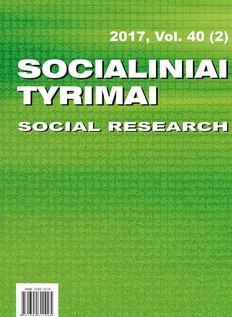Baltijos šalių biržose prekiaujamų investicinių fondų efektyvumo vertinimas rizikos-pelningumo požiūriu
Assessment of Risk-Adjusted Performance of Investment Funds Traded in the Stock Exchange of the Baltic Countries
Author(s): Vilija Aleknevičienė, Laura ŽvinklytėSubject(s): Business Economy / Management, Economic history, International relations/trade, Transformation Period (1990 - 2010), Present Times (2010 - today), Financial Markets
Published by: Vilniaus Universiteto Leidykla
Keywords: investment funds; risk-adjusted performance; risk, return; asymmetry; kurtosis;
Summary/Abstract: Recently, researchers have been paying increasingly more attention to risk-adjusted performance of investment funds. Nevertheless, the asymmetry, the smoothness or the peakedness of returns have been poorly explored. In addition, most researches have been carried out in well developed, liquid and efficient markets. In this study, risk-adjusted performance of investment funds traded in the stock exchange of the Baltic countries was assessed using Sharpe and Sortino ratios as well as skewness and kurtosis. There are 38 investment funds traded in the stock exchange of the Baltic countries. However, most of these funds have been offered to public only recently. Thus, in order to have a research period as long as possible, only 14 funds were selected: 4 equity funds, 4 bond funds and 6 funds of funds. The period of investigation is 2008-2016. The research results revealed that only bond funds and one equity fund (ZPR Global Equity) were efficient in 2008-2016. This equity fund mostly invested in companies from the USA, where the economy, hit by the financial crisis, began to grow at a fast pace. All funds of funds were inefficient. This research was conducted in a relatively illiquid and inefficient market, but the investors’ behaviour during the economic downturn and slow growth period was the same as in efficient markets: they shifted their investments from equities to bonds. Consequently, additional demand increased bond market prices and returns. Despite the fact that only bond funds were efficient, their skewness and kurtosis were negative and greater in comparison with equity funds and funds of funds – the return distribution in bond had a greater downside. Moreover, bond funds were: 1) more overestimated by Sharpe ratio than equity funds and funds of funds; 2) their return distribution had a greater gain/loss than could be expected from a normal distribution; 3) their kurtosis were greatest in comparison with the kurtosis of equity funds and funds of funds. It should be emphasised that if the investor considered large negative skewness and very large positive excess kurtosis, he would come to a different conclusion. This is particularly important for intermediately and highly risk-averse investors. The analysis showed that almost all investment funds (with exception of one) had negative skewness (greater downside events), making the use of standard deviation and reliance upon normal distributions much less relevant for understanding the true risk of investment funds. 13 investment funds had leptokurtic return distributions, and 1 fund – platykurtic. Compared to a normal distribution, the latter tails are shorter and thinner. An asymmetrical return distribution and fat tails lead to the danger of underestimating risk and overestimating risk-adjusted performance with standard risk and performance measures.
Journal: Socialiniai tyrimai
- Issue Year: 40/2017
- Issue No: 1
- Page Range: 5-16
- Page Count: 12
- Language: Lithuanian

